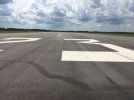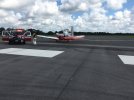I feel like I've mentioned it on here before, but:
TLDR: I pulled the engine off on an SNA and dead sticked it in from high key.
Brand new IP, instructing an Aero flight in the Pensacola South MOA. Typical late summer day, so afternoon cloud buildups but nothing crazy. Set SNA up for an easy simulated Eng Failure (for him to practice the "Eng out flare") coming out of 10k, he does his EP steps and I set 4-6% TQ to simulate engine shutdown. Dodging clouds, we get a TCAS hit approaching high key, I can't see them visually (probably busted Cessna out of Foley), I take controls from the SNA and power up and away and reset him. Second attempt, headed into high key, another TCAS hit but on the aft quarter, I give the EP, he calls for simulated shutdown, and
I pull off the PCL. ?
If you've never heard the PT6 feather in flight, it's one of the most disconcerting sounds I've ever heard, followed by eerie silence, then lots of alert tones. I take controls from the SNA as we're coming through 3500 into a very nice high key, start the air restart procedures by motoring the engine, then (Very briefly) think about props coming out of feather effecting sink rate during the ELP and elect to just fly the ELP with the penguins I had left on my iceberg. Gear came down with the residual HYD pressure from motoring the engine, flew an okay-ish ELP with an overshooting crosswind and crossed the threshold around ~130KIAS with the flaps fully down and a bit high. I'll admit I was more concerned about shorting it, so probably flew it a bit tight to hit the runway with good lineup.
Flared for what seemed like an eternity to bleed off the speed and take lift off the wings to land.
@Jim123 point about the physics of engine out is on point. I felt like the 4-6% simulated we did to practice was a good approximation for training. Mains touched with about 1500ft of runway (good ole Summerdale with 4k ft) + 300ft of paved over-run. Got on the brakes pretty strongly with the 1 board zooming by, locked up the mains and blew them with a few hundred left and rode the rims before stopping in the overrun. Crash truck pulls up as I'm opening the canopy, catching my breath, and pulling the seat cushion out of my asshole.
Aftermath: Two new tires/rims made it a HAZREP in terms of cost. That was it. I had a good CO who recently had a mishap doing an FPC (the TW-5 bird that had been in the hangar for 3 years as of 2019 with the "replace wing" MAF if you know it). I gave him the whole story, he laughed, congratulated me on fucking up and then doing what I was trained to do to save the SNA, myself, and the plane. Quick IP Prof with a DCON Stan IP the next day and I was back flying with SNAs with a good ready room story.
I'd say other IPs I talk to are 50/50 on the engine restart or forced landing. I tried it in the sim and it totally flies away with enough time. The JPATS engineers I talked to however said the aerodynamic modeling of the prop somewhere between feather and idle is done, so actually the sim isn't super accurate there.
On centerline until riding the rims made me a bit squirrelly:
View attachment 27702
Stopped. MX came later that day with tires and towed her to parking. Flew home a week later after they verified the engine was fine.
View attachment 27701




